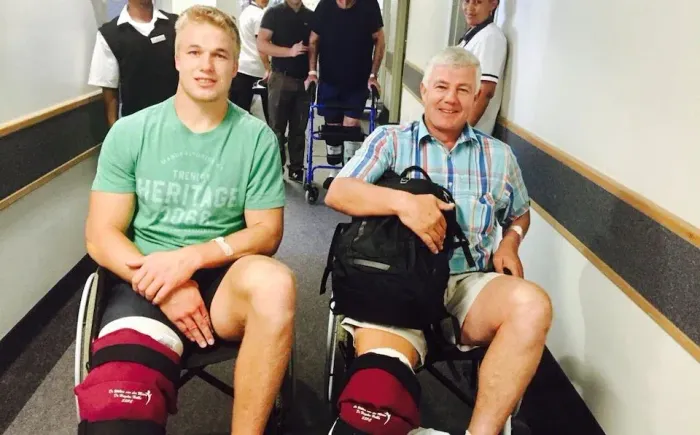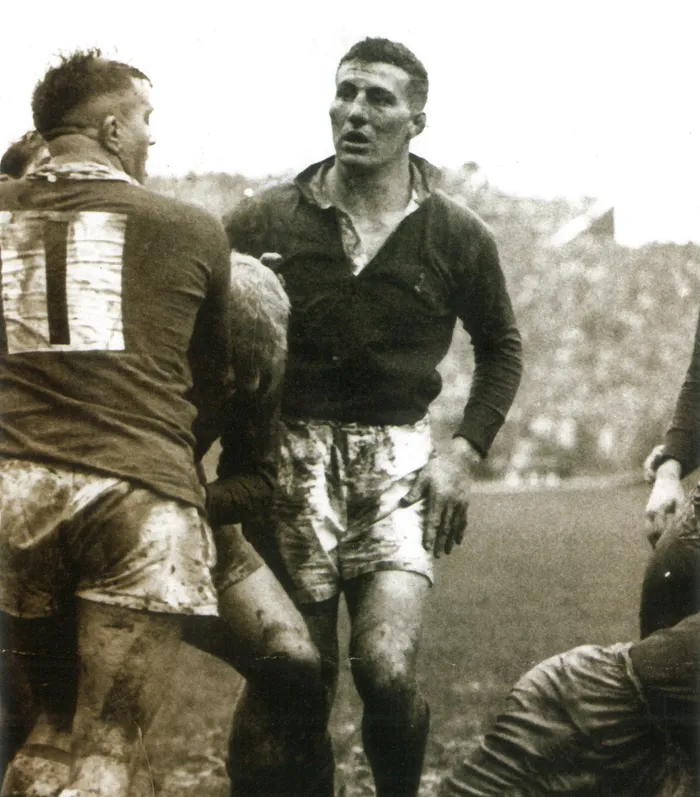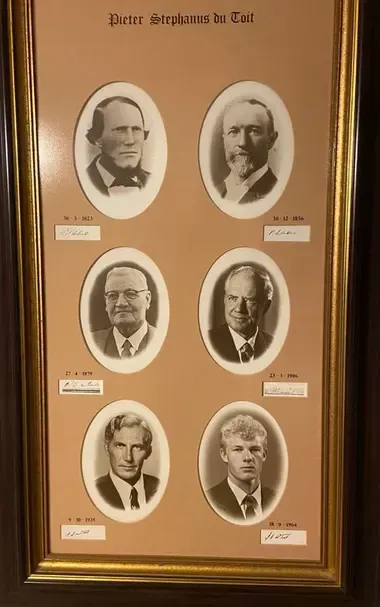The fighting spirit of Pieter-Steph du Toit: A legacy written in blood, sweat and family
RUB OF THE GREEN

FILE - Pieter-Steph du Toit celebrates with his family after the Springboks won back to back Rugby World Cup titles in France.
Image: AFP
The remarkable thing about Pieter-Steph du Toit featuring in Saturday’s Rugby Championship match against the Pumas in Durban is that he could only do so because his father donated part of his hamstring to his son.
It was six months before the 2019 World Cup that Pieter-Steph’s knee was so badly injured that doctors said nothing could be done. His career was over. But medical science had not reckoned with the legendary fighting spirit of the Du Toits — more of which later.
Du Toit famously gets his strength from his grandfather, Piet “Spiere” du Toit, who played 14 Tests at tighthead prop for the Springboks between 1958 and 1961.
“He died when I was four, but I recall him tossing me about with those powerful arms,” Du Toit told me. “He was just 60 when he died in 1996. He was very fit and the week before he died he had run a marathon.
“The workers on the farm tell stories of his strength. Once he held a tractor so that the wheel could be changed because they could not find the jack.”

Pieter-Steph and his father, Pieter, leave the hospital after Pieter had donated part of his hamstring to his son to repair a knee ligament injury.
Image: Supplied
The next words out of his mouth came as no surprise: “I grew up with a sense of destiny and of value in my heritage. This has always resonated with me. I feel a sense of responsibility carrying this name.”
Let me explain. This Springbok phenomenon is not the first Pieter-Steph du Toit, not by a long shot. Soon after the first Du Toits came to South Africa in the 1690s as Huguenot refugees from France, a tradition began where the eldest son is named Pieter-Stephanus du Toit.
There have been eight generations of Pieter-Stephs making wine in the Boland since the 1820s. No wonder the current incarnation has a sense of destiny.
The Du Toit farm, the renowned Kloovenburg Wine and Olive Estate, is at Riebeek-Kasteel in the heart of the beautiful Swartland. Pieter-Steph’s father (he calls himself Pieter but is also a Pieter-Stephanus) is a winemaker and his mother makes olive oil.
The 1960s Springbok jerseys of Piet (also a Pieter-Stephanus) du Toit are on display in their farm’s cellar from where they sell their products, and in a 2013 interview, the 20-year-old Pieter-Steph told me he was determined to add to the collection.
“I am the oldest of four boys and since all of us were small we have wanted to play for the Boks. I had a feeling I would walk in my grandfather’s footsteps from the day I found a pair of his old boots in a barn. I was very young and these old leather boots took me halfway to my knees. My dad had the foresight to let me wear them rather than stick them on a mantelpiece. I ran around in them until they fell apart.”

Pieter-Steph's grandfather, Piet du Toit, in action for the Springboks in Cardiff in 1965.
Image: Supllied
Six months after that interview, Pieter-Steph had walked in his grandfather’s Springbok footsteps when he made his debut for South Africa on November 9, 2013, against Wales in Cardiff — a game the Boks won 24-15.
“The farm is very much in my blood,” Pieter-Steph has said. “It is why I went to the small local school and not to a big rugby boarding school. I got a bus into Malmesbury every morning and my mother would pick me up at 6pm after sport, and then I had the evening on the farm. I would rather work on the farm than go party with my friends. I would get them to come to the farm.
“There is something special in working with nature, watching the grapes grow and finally get harvested.”
Pieter-Steph’s desire to take up full-time farming almost came true sooner than he would have liked. Calamitous injuries forced him to invoke the fighting spirit of his ancestors.
Let me give some background. Pieter-Steph’s great, great, great grandfather (Pieter-Stephanus du Toit II) was a sheep farmer who settled in a remote part of the Karoo where only the toughest of farmers could succeed.
Once a month he would travel to the nearby towns to sell his produce and to indulge his appetite for bare-knuckle boxing with similarly tough farmers. This early Pieter-Steph never lost a fight.

The Pieter-Steph currently playing for the Springboks has six generations of Pieter-Stephs behind him.
Image: Supplied
The Pieter-Steph of 2019 had to summon that fighting resolve when he suffered an anterior cruciate ligament injury six months before the World Cup in Japan. This severe setback came soon after he had recovered from a similar injury in 2018.
Doctors told him his World Cup dream was over.
But the indomitable spirit of six previous Pieter-Stephs came to the fore. It was Pieter du Toit, Piet’s son and Pieter-Steph’s father, who solved the situation.
“I don’t know where the thought came from,” Pieter said. “I think it must be God who put that thought there. I asked the doctor if a piece of my hamstring could work as a tendon on my son’s knee. He agreed that this was a very unusual but probably brilliant remedy.
“So, they took a slice out of me like biltong to strengthen Pieter-Steph’s ACL,” Pieter says. “We both went out on wheelchairs but then I was walking first, which I like to remind him of.”
The history books record in neon lights that seven months later the Springboks won the World Cup and Pieter-Steph du Toit was crowned the Player of the Tournament and also the 2019 World Rugby Player of the Year.
As the poet Alfred Lord Tennyson wrote: “More things are wrought by prayer than this world dreams of.”
This story is an extract from Mike Greenaway’s best-selling book, The Fireside Springbok. He also penned Bok to Bok, the recollection of the Springboks’ 2023 World Cup triumph.
Related Topics: